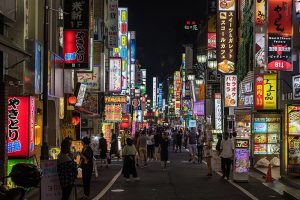COVID-19’s persistent presence in Japan — with, as of early September, more than 600 daily reported cases on average — has been very often associated with a district called “Yoru no Machi” by Japanese media and politicians. The term literally means “night city” and vaguely refers to host clubs, sex establishments, and night clubs, implying physical contact.
Or does it? Actually, it’s not entirely clear what Yoru no Machi means.
It was not until the phrase was adapted as a proper noun in the context of the pandemic that the general expression became popularly used by the media and the politicians. Japanese Prime Minister Shinzo Abe, who announced his sudden resignation on August 28, first used the term in a press conference declaring national emergency measures on April 7. Although he did not give any specific emphasis to the term, his use seemingly inspired others, who slowly started adopting the idiom afterward.
Since then, the term has been effectively functioning to grant the public — except for workers of the pointed establishments, of course — a sense of pseudo-relief. The phrase implies the belief that Japan’s COVID-19 outbreaks are happening “out there,” by imputing the responsibility to certain areas. At first, Yoru no Machi predominantly referred to host clubs in Kabukicho, a famous red-light district in Tokyo. This was due to the fact that Japan’s cluster-based approach to the pandemic had identified several outbreaks in the area by early June, shortly after the state of the emergency was lifted. The reports were conspicuous as Tokyo’s daily cases were being contained below 100 at the time.
Consequently, the host clubs had the bitter experience of bearing the brunt of the finger-pointing, with accusations that they had failed to avoid the “Three Cs” (closed spaces with poor ventilation, crowds, and close-contact settings), the Japanese golden rule to prevent infections. In her press conferences, Tokyo Governor Yuriko Koike cautioned the public many times to avoid such places, even putting up a signboard ascribing the outbreak to Yoru no Machi.
On July 12, Osaka Governor Hirofumi Yoshimura emphasized that the Yoru no Machi district had been playing a large role in transmissions in the city. This was ironic, because he had commented on the same day that defining Yoru no Machi is practically impossible.
Of course, there has been strong push-back against the heavy use of the ambiguous term by the media and those in power. In an interview with The Asashi Shimbun, Makoto Sato, a former employee of a host club, pointed out that the term is divisive and stigmatizes workers in red-light districts. It is also claimed that blaming the district over-simplifies the situation, as most establishments are taking preventive measures against the infections. It is also important to note that the country’s clusters are not confined to nightlife districts at all and have been found in many other places like hospitals and high schools.
According to a Tokyo Shimbun article, Yoshimura has been attributing the wide spread of the virus in Osaka to the young people in Yoru no Machi. The article argues that this emphasis could have given a false sense of security to the middle-aged and the elderly, who are comparably vulnerable to the virus, and thus led to a worrying increase of the cases among them.
Another defect in blaming these “night” districts for the spread of COVID-19 is also that the discussion too often overlooks the other side of the coin, which is the fact that clients of Yoru no Machi are generally daytime workers. This truth was highlighted via the scandal of a lawmaker who was blamed for visiting an adult entertainment club during the national emergency in April, when refraining from going out was strongly recommended. However, it appears that this one-sided narrative — where workers, and not customers, are blamed — and the very scapegoating that critics denounce are precisely what makes Yoru no Machi such a convenient term and, thus, splashed in the coverage.
Another secret of its popularity is perhaps that the loosely defined term can tune its meaning to a wide range of speakers with different motivations. Taking their lead from national newspapers, local newspapers in, for example, Aichi, Ibaraki, Okinawa, and Niigata reported that the outbreaks had been freshly identified in Yoru no Machi in their own prefectures in August, widening the term’s meaning from red-light districts in Tokyo to nationwide. Even more broadly, the idiom is sometimes used to introduce the entire nightlife district of a city, including bars and restaurants where no physical contact is connoted. Iwate Nippo and Chunichi Shimbun, the local newspapers of Iwate and Aichi, used the term in the headlines of their articles interviewing restaurant owners. Tabloid magazines have also made frequent use of the buzzword to add a sensational touch to their articles.
Yoru no Machi, even though patronized by daytime workers, has been excessively accused of spreading COVID-19 by Japanese media and politicians and, simultaneously, treated as if it is an isolated place in a bid to reassure the general public. This has been sustained by the term’s plasticity, as it can refer to different things, from red-light districts in Tokyo to nightlife districts in general anywhere around the country. However, abuse of this ambiguous term, which gives false sense of security by scapegoating a few, is deeply problematic since the pandemic still needs to be combated with everyone’s precautions.
Yusaku Yoshikawa is a member of staff at a consultancy firm and currently engaged in Japanese Official Development Assistance (ODA) Projects in Africa. He completed his Master’s degree, majoring in anthropology, at Wageningen University and Research, the Netherlands.
































